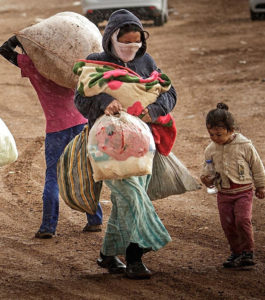When most people think of the Afghan evacuation, they think of August of 2021, when crowds surged around Kabul’s airport, desperate and doomed Afghans clung to the sides of planes taking off, and a suicide bomber murdered scores of Afghans and 11 U.S. Marines, one soldier, and one Navy Corpsman. And they think the evacuation is over. But the evacuation of Afghans never ended. And neither has the volunteering by people all over the world trying to get vulnerable people out.
Jeff Phaneuf of No One Left Behind, the largest volunteer organization working to assist Afghans who served the USA as interpreters, has noted that when the organization surveyed its 16,000 contacts in August 2022, it found 180 clear instances of Afghans killed while waiting on a visa, with a 80 further possible murders they’re looking into. No One Left Behind estimates that there are close to 200,000 people still in Afghanistan eligible for visas from the USA set aside for Afghans and their family members who are at risk because of work they did for the USA. That doesn’t count the women’s rights activists other groups are working on. Those Afghans who do make it out often exist in an indeterminate legal space because of the inaction of governments to give them permanent status. Many of the people in Afghanistan that volunteers abroad are trying to help are literally starving: in August 2022, when No One Left Behind asked Afghans applying to leave about the conditions they lived under, only 5.5% reported being able to feed their families.
This Time article profiles the work of people, most of them volunteers, who are still in contact with Afghans in Afghanistan and are continuing to try to get people, especially women, out of Afghanistan and to a safe country with official asylum status, and focuses on their macabre mascot, Our Lady of the Manifest, “She’s who we pray to, to get people on flights” – and how she’s helping volunteers facing mounting fatigue, frustration, depression and stress as they feel a growing helplessness to assist Afghans.
The article notes what everyone faces in trying to get at-risk Afghans out of Afghanistan:
You can get every necessary document in order, push your case through the sluggish and unresponsive refugee system, get every name of the family you’re working with on a flight manifest, and somewhere between that Afghan family’s home and the airport they can run into the “18-year-old with a gun” problem—a young Afghan running a Taliban checkpoint who doesn’t have much respect for international agreements or paperwork and who might be in a bad mood, or struck by how a woman is dressed, or acting, or who just doesn’t like the idea of a family who wants to flee the country. Everything can fall apart in a moment.
As the author of the article notes, “Sometimes, Our Lady feels a little less like an inside joke with these volunteers trying to get Afghans out, and more like a companion on a painful road.”
These volunteers work mostly in isolation. Even with online communities and interacting with others remotely, volunteers can feel very unsupported and alone, especially when friends and family are more than ready to move on and stop talking about this. I know, because I am such volunteer: I wrote about my efforts two years ago as a part of Digital Dunkirk: online volunteers scrambling to help endangered Afghans get visas & out of Afghanistan and the mental and emotional toll I could see it taking on others and myself. There’s no organization supporting me or guiding me in this role – myself and other volunteers are all pretty much making it up as we go along, because the guidelines and information about getting people out of Afghanistan and into an asylum program are ever changing. Most of us, including myself, have no training in interacting with people witnessing and experiencing violence, who have no safe haven from those acts – but we are interacting with Afghans, via WhatsApp, Telegram and Signal – that live in this daily reality and want our help. In addition, many of these volunteers, myself including, know that there are people – former colleagues, real people, with names and stories, who are in the photos we have of our time there – who qualify, on paper, to come to the USA, but are still languishing in a country run by terrorists 18 months later. As Laura Deitz of Task Force Nyx notes in the article, “I probably can’t underscore the toll that this mentally and emotionally takes on anyone who’s trying to help.”
And as I wrote in my earlier blog about this volunteering:
For the online volunteers trying to help, no certificate, no statistic on the monetary value of the time they contributed, no t-shirt, is going to serve as appropriate recognition for what they’ve done. There’s just one way we’re going to feel good about our virtual volunteering: getting people out of Afghanistan.
And I shall say it again, as I did two years ago:
Of course, the stress and frustration of online volunteers in this effort is nothing compared to the Afghans we’re trying to help. In addition to being terrified of the knock at the door that means the Taliban is there, to search the home, to take away boys and young men to fight, to take away girls for rape (there’s no such thing as “child marriage” – please stop saying that), to find files and data that could prove someone in the family worked with the USA, the UK, Australia, or some European country, Afghans are also running out of money and food.
I confess to having a very macabre sense of humor at times, and to gravitating to other humanitarian workers as colleagues and friends who also have such. It’s how I can face the absolute unnecessary absurdity of humanitarian work, whether internationally or just trying to help in my own community. This article provides a good profile of people who I think are like me – we don’t mean to offend. We’re just trying to stay sane.
I may print out a photo of Our Lady of the Manifest and put it on my wall.
If you have read this blog and are in the USA, I beg you to please write your US Congressional representative and both of your US Senators, as well as to the President of the USA, and ask them to please fulfill our commitment to our allies in Afghanistan, and to please put in the staffing and systems necessary to evacuate our allies and their families from Afgahnistan. They believed us – believe me – when we said they could and should pursue their education and careers, and they did so with the belief that we woud have their backs. We owe them this. And if you are in a country that worked in Afghanistan, whether militarily or in humanitarian interventions – Australia, the UK, Spain, Germany, Turkey, Japan, India, where ever – please do the same in your country regarding contacting your federally-elected officials.









